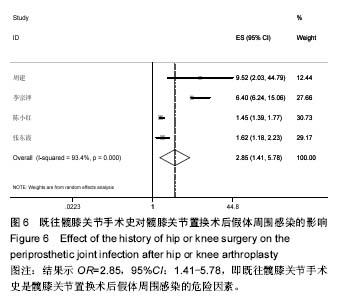| [1] Namba RS, Inacio MC, Paxton EW. Risk factors associated with deep surgical site infections after primary total knee arthroplasty: an analysis of 56,216 knees. J Bone Joint Surg Am. 2013;95(9):775-782.[2] Merollini K, Crawford RW, Whitehouse SL, et al. Surgical site infection prevention following total hip arthroplasty in Australia: Acost-effectiveness analysis. Am J Infect Contr. 2013;41(9): 803-809.[3] Pulido L, Ghanem E, Joshi A, et al. Periprosthetic Joint Infection: The Incidence, Timing, and Predisposing Factors. Clin Ortho Relat Res. 2008;466(7):1710-1715.[4] Tsung JD, Rohrsheim JA, Whitehouse SL, et al. Management of periprosthetic joint infection after total hip arthroplasty using a custom made articulating spacer (CUMARS); the Exeter experience. J Arthroplasty. 2014;29(9):1813-1818.[5] 周振宇.髋膝关节置换术后假体周围感染预防和治疗的相关研究[D]. 苏州大学, 2016.[6] Poultsides LA, Ma Y, Della Valle AG, et al. In-hospital surgical site infections after primary hip and knee arthroplasty-- incidence and risk factors. J Arthroplasty. 2013;28(3): 385-389.[7] 刘康妍. 120例人工膝关节置换术后感染诊断回顾性分析[J]. 中华关节外科杂志:电子版, 2013,7(2):19-22.[8] 陈鑫,朱雄白,黄小敬,等.全膝关节置换术后感染病原菌特点及危险因素分析[J]. 中华医院感染学杂志, 2014, 24(3):686-688.[9] 糜丽梅,吴姗, 张毓洁,等.人工膝关节置换术后感染的危险因素分析[J]. 中华医院感染学杂志, 2014, 24(7):1715-1716.[10] 周建. 膝关节置换术后感染的危险因素病例对照研究[D]. 浙江大学, 2014.[11] 梁嘉铭.影响膝关节表面置换术后感染的相关因素分析[J]. 骨科, 2015, 6(1):25-27.[12] 李宗泽.全髋关节置换术后感染的危险因素分析[J]. 辽宁医学院学报,2015, 36(5):21-23.[13] 陈小红,翁晓华,王葵儿.全髋关节置换术后患者感染的影响因素分析[J].中华医院感染学杂志, 2016, 26(1):131-133.[14] 张东霞,李国红,侯照银,等. 人工髋关节置换术后患者感染病原菌分析[J]. 中华医院感染学杂志, 2016, 26(6):1356-1358.[15] 王广芬,王福斌,黄童.人工关节置换术手术部位感染危险因素分析[J]. 医院管理论坛, 2015,32(9):46-49.[16] 胡美绘. 骨科关节置换手术部位感染独立风险因素评估及感染风险预测系统构建探索性研究[D]. 扬州大学, 2014.[17] 甘彦峰,余强,高峰,等.髋膝关节置换后手术感染危险因素分析[J]. 中国卫生产业, 2015, 12(27):165-167.[18] 吕增亮,葛武.髋膝关节置换术后假体周围感染的危险因素分析[J].中国临床研究, 2015, 28(11):1496-1497.[19] Wu C, Qu X, Liu F, et al. Risk factors for periprosthetic joint infection after total hip arthroplasty and total knee arthroplasty in Chinese patients. Plos One. 2014;9(4):e95300-e95300.[20] 徐瑜,毕宇芳,王卫庆,等.中国成人糖尿病流行与控制现状——2010年中国慢病监测暨糖尿病专题调查报告解读[J]. 中华内分泌代谢杂志, 2014, 30(3):184-186.[21] 宁光.糖尿病在中国——来自REACTION研究的发现[J]. 中华内分泌代谢杂志, 2015, 31(10):839-842.[22] Adams AL, Paxton EW, Wang JQ, et al. Surgical outcomes of total knee replacement according to diabetes status and glycemic control, 2001 to 2009. J Bone Joint Surg. 2013; 95A(6):481-487.[23] Parkinson RW, Kay PR, Rawal A. A case for one-stage revision in infected total knee arthroplasty? Knee. 2011;18(1): 1-4.[24] 王悦.中国人口老龄化对经济增长影响的空间计量分析[J]. 社会科学研究, 2015,(5):73-78.[25] 张先龙,沈灏,王俏杰. 髋关节假体感染的临床和基础研究进展[J]. 中华关节外科杂志:电子版,2014, 8(1):1-3.[26] Lewis SS, Dicks KV, Chen LF, et al. Delay in diagnosis of invasive surgical site infections following knee arthroplasty versus hip arthroplasty. Clin Infect Dis. 2015;60(7):990-996.[27] Mortazavi SM, Molligan J, Austin MS, et al. Failure following revision total knee arthroplasty: infection is the major cause. Int Orthop. 2011;35(8):1157-1164.[28] 刘冰,王英振,夏长所.关节置换术后假体感染的诊断与治疗研究进展[J]. 中华临床医师杂志:电子版, 2012, 6(8):1986-1988.[29] 吕佐,金以军.人工膝关节置换术围手术期感染的预防与控制[J]. 中华医院感染学杂志, 2011,21(12):2457-2458.[30] Newman ET, Watters TS, Lewis JS, et al. Impact of perioperative allogeneic and autologous blood transfusion on acute wound infection following total knee and total hip arthroplasty. J Bone Joint Surg. 2014;96(4):279-284.[31] Walker LG, Sledge CB. Total hip arthroplasty in ankylosing spondylitis. Clin Orthop Relat Res. 1991;29(262):198-204.[32] 张明德,朱俊峰.全髋关节置换术后感染的危险因素分析及早期诊断[J]. 重庆医学, 2013,42(33):3999-4001.[33] Greene KA, Wilde AH, Stulberg BN. Preoperative nutritional status of total joint patients : Relationship to postoperative wound complications. J Arthroplasty. 1992;6(4):321-325.[34] 范贵富,罗勇,刘鸿,等.人工关节置换术后感染原因分析及预防对策(附256例报告)[J]. 中国实用医药, 2013, 8(21):149-151. |
.jpg)


.jpg)